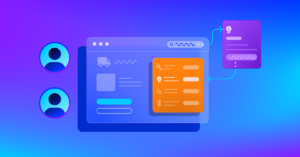
We live in a fast-paced world where speed is almost everyone’s priority. This makes us crave for things that help us to achieve that speed better.
That is the sole reason why cars, trains, airplanes, ships, and almost everything were invented in the first place.
The digital space, too, is full of new inventions. Computers were created to calculate things faster, the internet was created to browse things faster, and the biggest creation of the digital space is probably the Smartphone.
And even with smartphones, the only thing we crave for is speed. This is where mobile apps come in.
They are fast, easy to use, and customer-centric. In fact, among all mobile users, 86% spend their time on one or the other app.
Undoubtedly, with the number of Smartphone users growing with each passing day, the popularity of mobile apps, too, is gaining a similar momentum.
Consequently, the mobile application developers are becoming increasingly popular in the market with their demands growing many folds in the past few years.
It is indeed a very lucrative opportunity but competitive nonetheless. However, creating an app from scratch would require one to have a certain degree of prerequisite knowledge about a number of things which include determining objectives, potential costs, and project management among many others.
So, if one day you just wake up and get an amazing idea to develop your first mobile app, here is a step-by-step guide to help you develop the mobile application of your dreams:
- Determine The Goal And The Objectives
- Plan Key Features And Functionalities
- Research
- Design Wireframes
- Choosing A Development Path
- Building The Mobile App
- Testing The App
- Launching, Promoting, And Marketing The App
Step 1: Determine The Goal And The Objectives
The first step of every single task that one carries out is determined by its objectives. Similarly, in the process of developing your first mobile app, the primary work should focus on determining the objectives of the app.
What it does, what problems would it solve, who is the target audience of the app, which mobile platforms, devices, and operating systems would support it, and what do you have to gain from it? A good mobile app can definitely boost one’s business, and their image in the market can help them get better returns and ensure loyal customers.
Another important thing to keep in mind at this stage is the management of finances – how much money you want to use for developing the app, on its marketing, and on its final release.
Step 2: Plan Key Features And Functionalities
One of the most important steps in building a mobile app is laying out its design, its key features, and functionalities.
App developers should focus on UI design, platform design standards, ML, AI, etc. Other features such as real-time tracking, payment getaways, and anything that enhances the functionality of the app and solves the problems of users daily should be included in the design.
However, the point to be noted here is that adding irrelevant features won’t ensure the success of an application.
At the initial stage, it is advisable to only list down the features that would add a certain level of value to the app.
Once the app is in its preliminary stages, relevant features can be added and irrelevant ones omitted out.
For example, the features in a yoga app would be very different from those of a gaming app or a shopping app.
So, it is imperative for app developers to keep in mind the purpose of the app while developing the same.
Step 3: Research
The research should have a few main purposes:
- Finding out if there are other apps that provide the same set of services like yours; find out their gaps and improve yours upon them
- Finding out information about the technical requirements for developing your app
- Look for design inspiration
- Determine how much you should charge for the app and how you would monetize it.
Keeping these pointers, among others, in mind would help you to understand the market and the customer demand better.
However, with almost over 1 million apps on iOS and android platforms, it is almost impossible to create something completely new.
Nevertheless, one should not be discouraged as there is always room for improvement, even in the existing apps.
What is important is that you should focus on your own project, learn from the previous mistakes of other developers in that field, and move ahead.
The second thing to keep in mind is whether the idea is realistic or not from a more technical standpoint.
The research should also extend to exploring the legal restrictions of copyright and privacy issues.
Moreover, now would be a good time to seek mobile app developers as they would be able to provide you with a better insight into the workings on this industry as they would have firsthand experiences. However, before hiring a mobile application developer, one should check their credibility and previous work, and proceed from there only if one is satisfied.
The last point to give importance to is about how to monetize your app – whether the users will have to pay before downloading the app or pay after a trial period, would it be free or run on advertisements, and whether it will have in-app purchases, etc.
There are various ways in which one can monetize an app and it is up to you which channel you want to go after.
Step 4: Design Wireframes
Wireframing is about the visual representation of the app layout and the flow between different screens.
It is like creating a prototype of your app. It can be done online as well as offline. There are several online wireframing apps such as NinjaMock, Fluid UI, Adobe Suite, etc, while offline methods simply include the use of pen and paper.
Once you are working on the wireframes, a storyboard for your app should also be focused upon as it would help in understanding the connection between each screen and how users can navigate through the app.
After you are done with developing the wireframes, it is now time to test them. There are many online ways one can do that, with apps like Invision or by making use of companies that provide mobile app developers for hire.
After the tests, it would help one to understand the functionalities and the faults of the app better.
Step 5: Choosing A Development Path
Selecting the right development path is the next task while developing the first mobile app. The development approach should always complement one’s time and budget constraints. There are three possible approaches that can be pursued:
- Native apps
- web apps
- hybrid apps
Native apps:
Native apps deliver the best user experiences but take up a significant amount of time, apart from being costly and require skills and expertise as they are very platform-specific.
Web apps:
Web apps are relatively cheaper as compared to the native apps to develop and can easily run on various platforms by using HTML5, CSS, JavaScript code, but are less powerful than the former.
Hybrid apps:
They combine the best features of the native apps with on-the-fly web coding. The app developer combines the web code with native language to create unique features that are not yet accessible through JavaScript.
After deciding on the development path and the subsequent programming language, the next step is to build the app.
Step 6: Building The Mobile App
Now is the time to actually build your app, for which you can also use companies that have mobile application developers for hire services.
Things to keep in mind during this stage are: getting rid of unnecessary elements, not overusing push notifications as it often irks the user, using a single field as much as possible, future-proofing the app by leaving room for future improvements and additions, and most importantly, choosing the right and a speedy database for your app.
Step 7: Testing The App
It is important to test the app as it would ensure that there are no bugs and the user experience is seamless.
There are mainly two ways of testing an app – Internal and external. While in internal testing you use the app as the end-user, in external testing you give it out to people who have not worked on the app.
If you do not want to give your first mobile app out to other people, there are other tools for external testing such as TestFairy, UserTesting, etc.
Step 8: Launching, Promoting, And Marketing The App
After all the hard work, it is now time for the world to see what you have to offer. The first step is submitting the app to the platform of your choice – Play Store or App Store.
Once you have followed the guidelines of the respective platforms and have made the app public, now the task is to grab some eyeballs.
You can start by promoting it across social media, through emails, through websites, or by advertising it through other online platforms.
What’s Next?
The article provides some useful insights on how to develop your first mobile app. As your app starts getting traction, steps should be taken to improve its functionalities over time by rolling out new updates.
However, if you need any more guidance, there are many app development companies that can help in making your dream app a reality.
Author Bio
Tarun Nagar is the Founder & CEO of Dev Technosys, a global ranking custom ios app development company USA. With 10+ years of experience of enabling then Startups which are now global leaders with creative solutions, he is differentiated by out-of-the-box IT solutions throughout the domain.
He is known for his visionary qualities and adaptability for technology and trends, passionate as he is in every aspect dedicated to making IT simple, accessible and approachable for business enterprises.
Follow us on:-
Author LinkedIn Profile – www.linkedin.com/in/tarun-nagar-2a98b2117
Company LinkedIn :- www.linkedin.com/company/dev-technosys-pvt-ltd
Company Facebook :- www.facebook.com/devtechnosys/
Company Twitter :- twitter.com/devtechnosys

![HubSpot's 2025 State of Blogging Report [Data from 500+ Marketers]](https://www.liveseo.com/wp-content/uploads/2025/02/HubSpots-2025-State-of-Blogging-Report-Data-from-500-Marketers.webp-300x300.webp)


